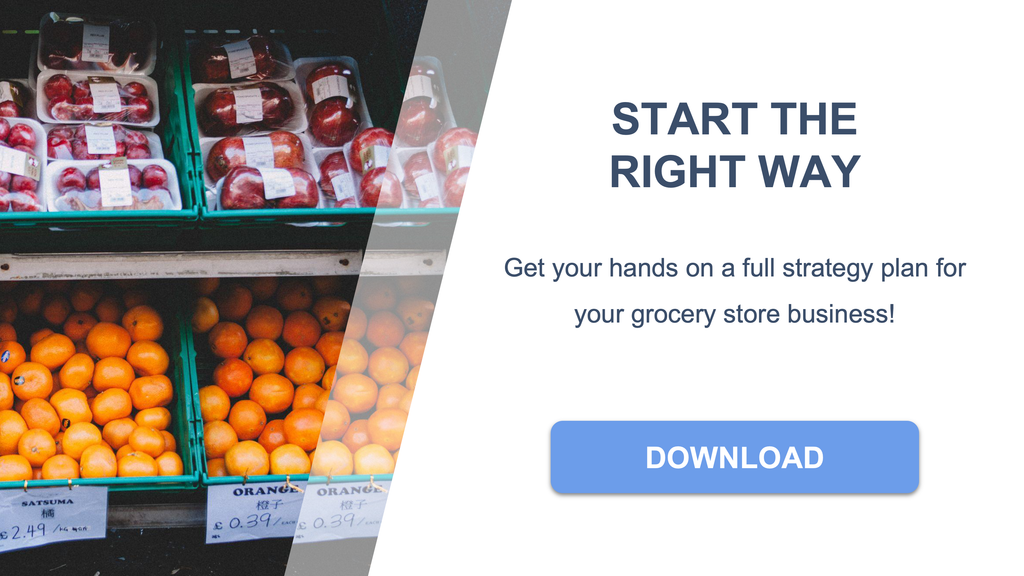This article was written by our expert who is surveying the industry and constantly updating the business plan for a grocery store.

Running a profitable grocery store requires understanding the financial benchmarks that define success in this high-volume, low-margin industry.
The grocery retail sector operates on tight margins where revenue varies dramatically based on store size, location, and operational efficiency. Whether you're planning to open a small independent grocery store or a larger supermarket, knowing the industry's financial realities will help you make informed decisions from day one.
If you want to dig deeper and learn more, you can download our business plan for a grocery store. Also, before launching, get all the profit, revenue, and cost breakdowns you need for complete clarity with our grocery store financial forecast.
Grocery stores operate in a challenging financial environment where success depends on managing razor-thin profit margins while generating sufficient sales volume.
The following table provides a comprehensive overview of the key financial metrics that define grocery store performance across different store sizes and market positions.
| Financial Metric | Typical Range | Key Details |
|---|---|---|
| Annual Revenue | $300,000 - $47 million | Small independent stores generate $300,000-$2 million; medium supermarkets average $8.5 million; large supercenters exceed $47 million annually |
| Net Profit Margin | 1-6% | Most grocery stores operate at 1-3%; large chains achieve 3-5%; premium/organic-focused stores can reach 6% |
| Gross Margin | 25-30% | Industry average after COGS, which typically consumes 70-75% of revenue; varies significantly by product category |
| Labor Costs | 10-18% of revenue | Small stores: 12-18%; medium stores: 10-15%; large chains achieve economies of scale with lower percentages |
| Cost of Goods Sold (COGS) | 70-75% of revenue | The largest expense for grocery stores, leaving a 25-30% gross margin to cover all operating expenses and profit |
| Revenue per Square Foot | Varies by location | Urban stores generate highest revenue per square foot but face higher rent and labor costs; suburban and rural stores have lower revenue density but reduced overhead |
| High-Margin Product Categories | 35-60% gross margin | Fresh produce (35%), meat/seafood (30-35%), ready-to-eat items (50-60%); packaged goods lower at 25-30% |

What is the average annual revenue of a typical grocery store?
The average annual revenue for a grocery store varies dramatically based on store size, with figures ranging from $300,000 for small independent stores to over $47 million for large supercenters.
Small independent grocery stores typically generate between $300,000 and $2 million in annual revenue. These smaller operations often serve local neighborhoods and have limited product selection compared to larger competitors.
Medium-sized supermarkets represent the traditional grocery store format and average approximately $8.5 million in annual revenue. These stores balance product variety with operational efficiency and typically serve suburban communities with populations large enough to support consistent foot traffic.
Large chain stores and supercenters can exceed $47 million per year in revenue due to their extensive product offerings, aggressive pricing strategies, and high customer traffic. The average revenue across all sole-proprietor grocery stores sits around $289,000, but this figure includes very small businesses and is not representative of typical supermarket operations.
You'll find detailed market insights in our grocery store business plan, updated every quarter.
What are the typical profit margins for grocery stores, and how do they vary by size and location?
Grocery stores operate with notoriously thin profit margins, with most stores achieving net profit margins between 1-3% of total revenue.
The profit margin reality in grocery retail is straightforward: this is a volume business where success comes from turning inventory quickly rather than marking up products significantly. Most independent and small-to-medium grocery stores operate at net profit margins of 1-3%, which means for every $100 in sales, they keep only $1-$3 as profit after all expenses.
Large chain stores achieve slightly better margins of 3-5% due to economies of scale, better negotiating power with suppliers, and optimized logistics systems. Premium or organic-focused grocery stores can reach net profit margins as high as 6% because they typically carry higher-margin specialty products and attract customers willing to pay premium prices.
Location significantly impacts profitability beyond just the margin percentage. Urban grocery stores face higher rent and labor costs but often generate more revenue per square foot, which can offset these expenses. Suburban stores benefit from balanced cost structures with good parking access and moderate competition. Rural grocery stores may have lower operating costs but generate less sales volume, though they can achieve higher margins when local competition is limited.
What are the main factors that drive revenue generation in grocery stores?
Revenue generation in grocery stores depends on multiple interconnected factors, with location and foot traffic being the primary drivers of sales volume.
Location determines your customer base size and accessibility. Grocery stores located near population centers with high foot traffic naturally generate more revenue than those in remote areas. Proximity to residential neighborhoods, parking availability, and visibility from main roads all contribute to customer convenience and frequency of visits.
Product mix and private label offerings play a critical role in revenue optimization. Stores that offer a balanced mix of staple items, fresh foods, and ready-to-eat options capture more wallet share from customers. Private label brands increase profitability by offering competitive pricing while maintaining higher margins than national brands.
Category focus directly impacts revenue performance. Grocery stores that emphasize fresh foods, ready-to-eat meals, and premium or organic products tend to generate higher revenue per customer transaction. The in-store experience, including cleanliness, product availability, and customer service, drives repeat business and community loyalty.
Store scale and operational efficiency determine how effectively you convert opportunities into revenue. Larger stores with optimized inventory management systems reduce stockouts and waste, while efficient checkout processes minimize customer wait times and improve satisfaction.
What is the average cost of goods sold (COGS) for grocery stores, and how does this affect profitability?
The cost of goods sold typically consumes 70-75% of a grocery store's revenue, leaving a gross margin of 25-30% to cover all operating expenses and generate profit.
COGS represents the single largest expense category for grocery stores and directly determines the gross margin available for covering operating costs. When COGS sits at 70% of revenue, the store has 30% gross margin remaining. From this 30%, the grocery store must pay for labor (10-18% of revenue), rent, utilities (1-2.5%), marketing, technology, inventory shrinkage, and other operating expenses before reaching net profit.
This tight relationship between COGS and profitability explains why grocery stores focus intensively on supplier negotiations, inventory turnover, and waste reduction. Even a 1% reduction in COGS—from 71% to 70%—translates directly to a 1% improvement in gross margin, which can represent a 33-50% increase in net profit for stores operating at 2-3% net margins.
The impact of COGS on profitability becomes even more critical during periods of supplier price increases or supply chain disruptions. Grocery stores must carefully balance passing costs to customers versus absorbing them to remain competitive, which directly affects their ability to maintain consistent profit margins.
What are the typical operating expenses for grocery stores beyond COGS?
Operating expenses for grocery stores extend well beyond the cost of goods sold and typically include labor, rent, utilities, and various operational costs that collectively consume most of the remaining gross margin.
| Expense Category | Percentage of Revenue | Key Considerations |
|---|---|---|
| Labor Costs | 10-18% | Small stores typically spend 12-18% of revenue on labor; medium stores 10-15%; large chains achieve economies of scale with lower percentages due to better scheduling systems and automation |
| Rent/Lease | Highly variable | Urban locations command premium rents that can consume 5-10% of revenue or more; suburban and rural locations typically have lower rent but also lower revenue per square foot; lease terms significantly impact long-term profitability |
| Utilities | 1-2.5% | Includes electricity for refrigeration units, lighting, and HVAC; grocery stores require significant energy for maintaining proper food storage temperatures; energy-efficient equipment reduces this burden |
| Inventory Shrinkage | 1-2% | Losses from theft, spoilage, damage, and administrative errors; fresh produce and perishables contribute disproportionately to shrinkage; effective inventory management systems reduce this expense |
| Marketing & Advertising | 1-3% | Includes weekly circulars, digital advertising, loyalty program costs, and promotional materials; essential for driving foot traffic but must be balanced against tight margins |
| Technology & POS Systems | 0.5-1.5% | Point-of-sale systems, inventory management software, security systems, and customer relationship management tools; increasingly important for competitive operations |
| Insurance & Security | 0.5-1% | General liability, property insurance, workers' compensation, and security personnel or systems; costs vary based on location and store size |
| Maintenance & Repairs | 0.5-1.5% | Regular maintenance of refrigeration units, HVAC systems, flooring, and building infrastructure; preventive maintenance reduces costly emergency repairs |
What is the industry average for net profit margins in grocery stores?
The industry average net profit margin for grocery stores ranges from 1-3%, making grocery retail one of the lowest-margin industries in the retail sector.
This tight margin reflects the intensely competitive nature of grocery retail where customers are highly price-sensitive and readily compare prices across stores. Most independent and small-to-medium grocery stores operate at the lower end of this range, between 1-2% net profit margin, which means they must generate substantial sales volume to achieve meaningful absolute profit dollars.
Large chain grocery stores perform better with net profit margins of 3-5% due to their significant advantages in purchasing power, distribution efficiency, and operational systems. These chains negotiate better terms with suppliers, optimize logistics across multiple locations, and invest in technology that reduces labor costs and shrinkage.
Specialty grocery stores focusing on organic, premium, or ethnic products can achieve net profit margins of 5-6% when they successfully differentiate themselves and build customer loyalty. These stores serve niche markets where customers prioritize product quality and selection over price, allowing for higher margins on specialty items.
The razor-thin industry margins mean that grocery store operators must maintain exceptional operational discipline. A small increase in shrinkage, unexpected rent increase, or drop in sales volume can quickly eliminate profitability entirely.
How do grocery stores in urban locations compare to those in suburban or rural areas regarding revenue and profitability?
Urban, suburban, and rural grocery stores each face distinct revenue and profitability dynamics driven by their operating environments and customer demographics.
| Location Type | Revenue Characteristics | Profit Margin Potential | Cost Structure & Challenges |
|---|---|---|---|
| Urban | Highest revenue per square foot; smaller store formats compensated by high customer density and frequent shopping trips; typical basket size may be smaller but visit frequency is higher | Can be higher or lower than average; high revenue potential offset by elevated costs; success depends on operational efficiency and competitive positioning | Highest rent and labor costs; limited parking challenges some customers; intense competition; premium for real estate in high-traffic areas; higher security costs; delivery and restocking more complex |
| Suburban | Medium revenue levels; larger store formats with extensive parking attract family shopping trips; customers make fewer but larger shopping trips; steady predictable traffic patterns | Moderate margins with balanced cost-to-revenue ratio; typically achieves industry-average profitability of 2-3%; less extreme than urban or rural dynamics | Balanced cost structure; moderate rent relative to revenue; good parking and accessibility; competition from multiple grocery formats; must maintain competitive pricing while offering variety |
| Rural | Lowest absolute revenue due to smaller population base; larger shopping baskets per visit as customers stock up less frequently; limited competition can enable premium pricing in some markets | Can achieve higher margins (3-5%) when local competition is limited; lower costs allow for profitability despite lower volumes; vulnerable to new entrants | Lowest rent and labor costs; smaller customer base limits total revenue potential; longer supply chains increase COGS; limited labor pool; vulnerability to economic fluctuations in farming/resource communities |
| Tourist/Seasonal | Highly variable revenue based on seasonal patterns; peak seasons generate 2-3x normal revenue; must maintain operations during slow periods with minimal traffic | Annual margins depend on peak season performance; can match or exceed urban stores if peak revenue compensates for slow periods; requires careful cash flow management | Staffing challenges with seasonal hiring/layoffs; inventory management complicated by demand fluctuations; rent typically year-round despite seasonal revenue; must maintain relationships with seasonal suppliers |
This is one of the strategies explained in our grocery store business plan.
What is the typical gross margin for products in grocery stores, and which categories offer the highest margins?
Gross margins in grocery stores vary significantly by product category, ranging from 25% on packaged goods to 60% on ready-to-eat items.
| Product Category | Gross Margin | Sales Share of Total Revenue | Strategic Considerations |
|---|---|---|---|
| Ready-to-Eat Items | 50-60% | 8-12% | Highest margin category including prepared meals, hot food bars, and made-to-order items; requires skilled labor and kitchen facilities; growing category as convenience-seeking customers increase; spoilage risk higher than shelf-stable products |
| Fresh Produce | 35% | 14-15% | Strong margins but high spoilage risk; requires careful inventory management and quick turnover; customers view produce quality as key indicator of overall store quality; seasonal pricing variations affect margins |
| Meat & Seafood | 30-35% | 13-14% | Good margins with high customer loyalty for quality; requires butcher skills and proper refrigeration; customers willing to pay premium for quality and service; careful cutting and portioning reduces waste |
| Deli & Cheese | 30-40% | 6-8% | Strong margins on sliced meats, specialty cheeses, and prepared salads; requires skilled staff for customer service; builds store differentiation through variety and quality |
| Bakery | 35-45% | 4-6% | High margins on fresh-baked goods; in-store bakery creates appealing aromas and perceptions of freshness; day-old discounting reduces margins but minimizes waste |
| Packaged Goods | 25-30% | 24-25% | Lower margins but largest sales share; essential for driving traffic and competing on price; private label versions increase margins by 5-10 percentage points; long shelf life reduces risk |
| Dairy Products | 20-25% | 10-12% | Lower margins due to high competition and price sensitivity; frequently purchased items that drive store traffic; short shelf life requires careful ordering; often used as loss leaders |
| Beverages | 20-30% | 8-10% | Variable margins with premium craft beverages higher than sodas; heavy and bulky requiring storage space; promotion-sensitive category where margin erosion is common |
How do grocery stores manage seasonal fluctuations in revenue, and how do these affect annual profitability?
Grocery stores experience predictable seasonal revenue patterns with peak periods during holidays and summer months, followed by slower sales in January and February.
The November-December holiday period generates the highest revenue for most grocery stores, with weekly sales often 30-50% above average due to holiday meal preparations, entertaining, and seasonal specialty items. Summer months also see elevated sales as families increase fresh produce purchases, beverages, and grilling items for outdoor activities and gatherings.
The post-holiday period of January and February typically represents the slowest sales period as customers reduce spending after holiday expenses and many people focus on New Year's resolutions including diet changes that reduce grocery spending. This seasonal dip can result in weekly sales 15-20% below annual averages.
Successful grocery stores manage these fluctuations through several strategies. Inventory management becomes critical, with careful ordering during peak periods to avoid stockouts while preventing excessive inventory buildup that leads to waste after the season ends. Flexible staffing models allow stores to increase part-time hours during busy periods and reduce labor costs during slow months, helping maintain consistent labor cost percentages.
Targeted promotions during slow periods help maintain customer traffic and average basket sizes. Many grocery stores implement loyalty programs that offer bonus points or special discounts in January and February to encourage regular shopping trips even when overall spending is down. These programs help smooth revenue fluctuations throughout the year and improve annual profitability by retaining customer loyalty during all seasons.
What are the most significant trends impacting grocery store profitability in 2025?
Several major trends are reshaping grocery store profitability in 2025, with supply chain dynamics, consumer preferences, and technology adoption creating both challenges and opportunities.
Supply chain disruptions and cost volatility remain significant challenges for grocery stores. Inflation, tariffs, and international shipping constraints create unpredictable cost increases that squeeze already-thin margins. Grocery stores must decide whether to absorb these costs and reduce profitability or pass them to customers and risk losing price-sensitive shoppers to competitors. This dynamic has made supplier relationships and contract negotiations more critical than ever for maintaining stable COGS.
The growth of private label brands represents a major opportunity for improving profitability. Grocery stores are expanding their private label offerings across categories, capturing higher margins while offering customers value pricing. Private label products typically deliver margins 5-10 percentage points higher than national brands while still priced 15-20% below branded equivalents, creating a win-win for stores and customers.
Omnichannel retail continues to transform the grocery business model. The integration of e-commerce with traditional in-store shopping expands market reach but adds complexity and costs including order fulfillment, delivery logistics, and technology infrastructure. Successful grocery stores are finding ways to make online ordering profitable through minimum order requirements, delivery fees, and efficient picking processes.
Consumer preference shifts toward health, freshness, and sustainability are driving category mix changes. Customers increasingly prioritize fresh, organic, and locally-sourced products, which typically carry higher margins but also require more agile sourcing relationships and inventory management. Grocery stores that successfully adapt their product mix to these preferences can capture premium pricing while building customer loyalty.
We cover this exact topic in the grocery store business plan.
What role do loyalty programs and promotions play in boosting revenue and margins?
Loyalty programs and promotions serve as essential tools for maintaining customer traffic and protecting margins in the highly competitive grocery retail environment.
Well-designed loyalty programs increase customer retention by rewarding frequent shoppers with points, discounts, or exclusive offers. These programs provide valuable data on customer purchasing patterns, allowing grocery stores to personalize promotions and optimize inventory based on actual shopping behaviors. Customers enrolled in loyalty programs typically spend 15-25% more annually than non-members and shop more frequently, which helps maintain steady revenue even during slow periods.
Strategic promotions during slow periods help smooth seasonal revenue fluctuations by incentivizing larger basket sizes or purchases in typically low-traffic categories. For example, bonus point events on fresh produce in January can maintain produce sales when customers might otherwise reduce fresh food purchases. These targeted promotions protect margin by driving volume in high-margin categories rather than broadly discounting prices.
Digital coupons integrated with loyalty programs reduce the cost of traditional paper circulars while increasing redemption rates. Customers who actively select digital coupons demonstrate purchase intent, making these promotions more efficient than mass-market discounts. The data generated from digital coupon usage helps grocery stores refine their promotional strategies to maximize ROI on marketing spend.
Loyalty programs also help grocery stores compete against larger chains and discount retailers by building emotional connections with local communities. Personalized birthday offers, community donation programs, and member-exclusive events create differentiation beyond price that protects margins by reducing pure price competition.
How does the scale of the grocery store affect overall financial performance?
The scale of a grocery store—whether independent, small chain, or large chain—fundamentally determines its competitive advantages and financial performance potential.
Large chain grocery stores benefit from substantial economies of scale that translate directly to better financial performance. These chains achieve net profit margins of 3-5%, nearly double the 1-2% margins typical of independent stores. Their purchasing power allows them to negotiate lower COGS, sometimes 5-10% below what independent stores pay for identical products. This cost advantage can be passed to customers through lower prices while still maintaining superior margins.
Optimized logistics and distribution systems give chain stores additional advantages. Centralized distribution centers, sophisticated inventory management systems, and route optimization reduce transportation costs and improve product freshness. These efficiencies reduce overall operating costs by 2-3% of revenue compared to independent stores that rely on traditional wholesaler relationships.
Independent grocery stores face higher per-unit costs across nearly every category but can achieve profitability through niche positioning and community connections. Successful independent stores focus on specialty products, superior customer service, local sourcing, and personalized shopping experiences that justify premium pricing. An independent store might pay more for products but can build a loyal customer base willing to pay 5-15% higher prices for the unique value proposition.
Technology investments represent another scale advantage for chains. Large chains implement advanced point-of-sale systems, inventory optimization software, workforce management tools, and customer analytics platforms that independent stores often cannot afford. These technology investments improve operational efficiency and reduce labor costs by 1-2% of revenue while enhancing the customer experience.
The financial reality is that gross and net profit margins are almost always higher in well-run chain stores than in comparably sized independent operations. However, independent stores can achieve meaningful profitability by focusing on differentiation rather than competing directly on price with larger competitors.
Conclusion
This article is for informational purposes only and should not be considered financial advice. Readers are encouraged to consult with a qualified professional before making any investment decisions. We accept no liability for any actions taken based on the information provided.
Understanding the financial realities of grocery retail is essential for anyone considering entering this challenging but rewarding industry.
Success in grocery retail requires more than just stocking shelves and serving customers—it demands rigorous financial management, operational efficiency, and the ability to adapt to changing market conditions while maintaining the thin margins that define this industry.
Sources
- Projection Hub - Grocery Store Industry Financial Statistics
- Dojo Business - Grocery Profit Margin
- POS Nation - How Much Does a Small Retail Store Make
- Full Ratio - Profit Margin by Industry
- Hart Design - Grocery Retail Trends 2025
- McKinsey - State of Grocery Europe Report
- POS Nation - Grocery Store Profit Margins
- NielsenIQ - Grocery Trends
- Extenda Retail - 5 Key Grocery Retail Trends for 2025
- FMI - Food Industry Facts




